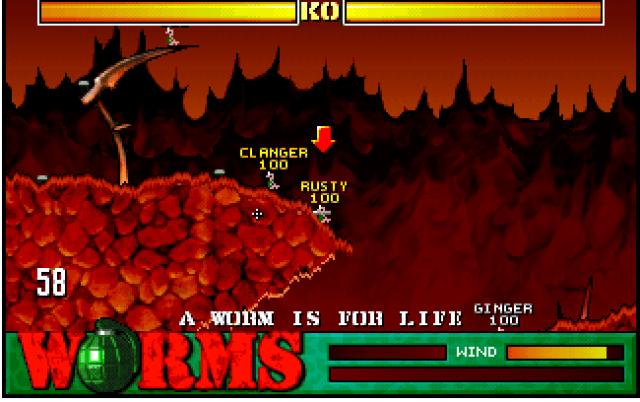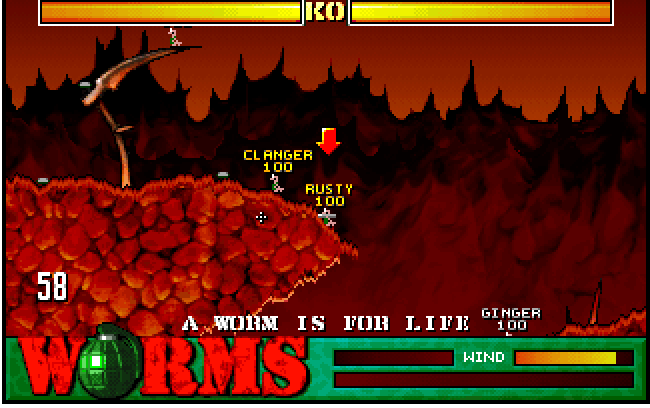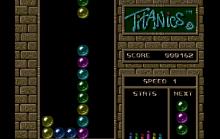Worms
Press Keyboard right side: Alt+Enter keys to switch to full screen game play, and Alt+Enter keys to return.
How to play Worms
Keyboard controls
Note: Some keyboards have limits on how many and which buttons may be pressed simultaneously. If you find that the game does not recognize some key presses when you hold down some buttons, you may need to change your keyboard or use a key remapper.
Key Purpose
Left/Right Moves selected worm in respective direction
Shift + Left/Right Forces worm to face one direction when moving
Shift or Middle Mouse Button Speeds up mouse cursor movement in-game by a factor of 4 when used separately or by a factor of 16 when used together
Right Mouse Button Opens and closes the weapon panel
Up/Down Adjusts aim for selected weapon in respective direction
Spacebar Fires or activates selected weapon
Tab Selects next worm on team when Worm Select is active
Enter Causes selected worm to perform a forward jump
Enter, Enter Causes selected worm to perform a backjump
Backspace Causes selected worm to jump vertically
Backspace, Backspace Causes selected worm to perform a backflip
Backspace, Enter Causes selected worm to perform a backjump
Backspace, Backspace, Enter Causes selected worm to perform a small backflip (identical to backjump in all but animation)
F1 - F12 Cycle through available weapons in weapon groups when selecting a weapon
Worms Description
Worms is a series of artillery tactical computer games developed by British company Team17. Players control a small platoon of worms across a deformable landscape, battling other computer- or player-controlled teams. The games feature bright and humorous cartoon-style animation and a varied arsenal of bizarre weapons.
The game, whose concept was devised by Andy Davidson, was described by the Amiga gaming press as a cross between Cannon Fodder and Lemmings. It is part of a wider genre of turn-based artillery games in which each player controls characters who duel with projectile weapons; similar games include Scorched Earth (1991), Gorillas (1991) and Artillery Duel (1983).
Worms games are turn based artillery games presented in 2D or 3D environment. Each player controls a team of several worms. During the course of the game, players take turns selecting one of their worms. They then use whatever tools and weapons are available to attack and kill the opponents' worms, thereby winning the game. Worms may move around the terrain in a variety of ways, normally by walking and jumping but also by using particular tools such as the "Bungee" and "Ninja Rope", to move to otherwise inaccessible areas. Each turn is time-limited to ensure that players do not hold up the game with excessive thinking or moving. The time limit can be modified in some of the games in the Worms series.
Over fifty weapons and tools may be available each time a game is played, and differing selections of weapons and tools can be saved into a "scheme" for easy selection in future games. Other scheme settings allow options such as deployment of reinforcement crates, from which additional weapons can be obtained, and sudden death where the game is rushed to a conclusion after a time limit expires. Some settings provide for the inclusion of objects such as land mines and explosive barrels.
When most weapons are used, they cause explosions that deform the terrain, creating circular cavities. The types of playable terrains include "island" (terrain floating on a body of water), or "cave" (cave with water at the bottom and terrain at both top and bottom of the screen that certain weapons such as "Air Strike" cannot go through; this type is not available in 3-D versions due to camera restrictions). If a worm is hit with a weapon, the amount of damage dealt to the worm will be removed from the worm's initial amount of health. The damage dealt to the attacked worm or worms after any player's turn is shown when all movement on the battlefield has ceased.
Worms die when one of the following situations occurs:
When a worm enters water (either by falling off the island, through a hole in the bottom of it, or by the waterline's being raised above the worm during sudden death)
When a worm is thrown off either side of the arena
When a worm's health is reduced to zero
Weapons and tools
The Worms series is particularly notable for its extensive variety of weapons. With each new game that is released, new weapons are added, though many were removed in the 3D versions for gameplay reasons. As a result, the 2D series has accumulated 60 weapons, and the 3D series 40 weapons.
The weapons available in the game range from a standard timed grenade and homing missiles to exploding sheep and the highly destructive Banana Bomb (possible reference to the weapons in Gorillas game), both of which have appeared in every Worms game so far. More recently, the Worms series has seen weapons such as the iconic Holy Hand Grenade, the Priceless Ming Vase and the Inflatable Scouser.
Some of the bizarre weapons in a particular game are based on topical subjects at the time of the game's release. The Mail Strike, for example, which consists of a flying postbox dropping explosive envelopes, is a reference to the postal strikes of the time, while the Mad Cow refers to Britain's BSE epidemic of the 1990s. The French Nuclear Test, introduced in Worms 2, was even updated to the Indian Nuclear Test in Worms Armageddon to keep with the times.
Other weapons are distinctly inside jokes. The MB Bomb, for example, which floats down from the sky and explodes on impact, is a cartoon caricature of Martyn Brown, Team17's studio director. Other such weapons include the "Concrete Donkey", one of the most powerful weapons in the game, which is based on a garden ornament in Andy Davidson's home garden, and an airstrike known in the game as Mike's Carpet Bomb was actually inspired by a store near the Team17 headquarters called "Mike's Carpets".
Since Worms Armageddon, weapons that were intended to aid as utilities rather than damage-dealers were classified as tools. This classification mainly differs in the fact that they do not fall in ordinary weapon crates, and instead appear in toolboxes. Many tools were left in the wrong class for the sake of keyboard-shortcut conveniences. This was resolved in Worms 3D.
Some weapons were inspired from popular Movies and TV programs, including the Holy Hand Grenade (from Monty Python and the Holy Grail) and Ninja Rope (named the Bat Rope in early demos of the original game)
Audio
One of the defining features of the Worms series is its light-hearted audio. Although the first few Worms games used darker, more authentic battlefield sounds for its ambient music, all of the games included a large number of high-pitched catchphrases shouted by the worms during the course of battle, such as "I'll get you!", "Revenge!", "Stupid!" and "Bombs away!".
Worms & Reinforcements United and its sequels gave players the ability to pick between a variety of speech sets (called "sound banks") for each platoon of worms. Many were based on regional accents, such as "The Raj" and "Angry Scots", while others, like "Drill Sergeant", made use of stereotypes. Players could even record their own speech sets and use those instead.
The ambient and theme music for Worms 2, Worms Armageddon, Worms World Party and, in part, Worms 3D, was entirely provided by Bjørn Lynne.
The whole Worms series has a light-hearted themesong, known as the Wormsong.
The game was originally created by Andy Davidson as an entry for a Blitz BASIC programming competition run by the Amiga Format magazine, a cut-down version of the programming language having been covermounted previously. The game at this stage was called Total Wormage (possibly in reference to Total Carnage) and it did not win the competition. Davidson sent the game to several publishers with no success. He then took the game to the European Computer Trade Show, where Team17 had a stand. Team17 made an offer on-the-spot to develop and publish the game.
t subsequently evolved into a full commercial game, renamed Worms, available initially only for the Commodore Amiga computer. As the game was extremely popular, it was regularly released for other platforms including Windows- and Macintosh-based computers, Atari Jaguar, Mega Drive/Genesis, Dreamcast, Nintendo 64, Game Boy, Game Boy Color and Game Boy Advance, GameCube, Nokia N-Gage, SNES, PlayStation and PlayStation 2, Sega Saturn, Pocket PC, and Xbox.
During the development of Worms 2, Andy Davidson wrote Worms: The Director's Cut, a special edition produced exclusively for the Amiga. This was, in his eyes, the pinnacle of the series. Featuring weapons not seen in any Worms game before or since, it looks like an enhanced version of the original game. Only 5000 copies were ever sold. It was also the last version released for the Commodore Amiga platform from which the game originated.

Worms - additional information
















